| Listing 1 - 10 of 53 | << page >> |
Sort by
|
Book
ISBN: 2251380639 9782251380636 Year: 2003 Volume: 57 Publisher: Paris : Les Belles Lettres,
Abstract | Keywords | Export | Availability | Bookmark
 Loading...
Loading...Choose an application
- Reference Manager
- EndNote
- RefWorks (Direct export to RefWorks)
Acculturation --- Rome --- History --- Civilization --- Provinces --- Administration --- Histoire --- Civilisation --- Augustus, 30 B.C.-14 A.D.
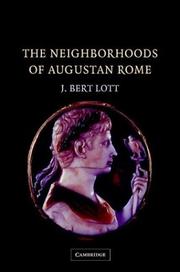
ISBN: 0521828279 9780521828277 9780521175494 Year: 2011 Publisher: Cambridge, UK ; New York : Cambridge University Press,
Abstract | Keywords | Export | Availability | Bookmark
 Loading...
Loading...Choose an application
- Reference Manager
- EndNote
- RefWorks (Direct export to RefWorks)
This volume investigates the neighborhoods of ancient Rome during the reign of the first Roman Emperor, Caesar Augustus (27 BCE-14 CE). Focusing on a group of neighborhood-based voluntary associations that were important political and social communities for the city's diverse population of slaves and ex-slaves, it locates the Augustan neighborhoods within the broader context of the history of Rome. John Bert Lott stresses their importance as physical and cultural divisions of the city and investigates the distinctive relationship between local neighborhoods and Augustus himself. An interdisciplinary study that makes use of archaeological, epigraphic, and topographic evidence, this book makes an important contribution to our knowledge of the urban life of Rome's lower classes and to our understanding of the imperial ideology that supported the development of the dynastic Roman monarchy.
Neighborhood --- Rome --- Social life and customs --- History --- Social life and customs. --- Neighborhoods --- Augustus, 30 B.C.-14 A.D. --- Neighborhood - Rome --- Rome - Social life and customs --- Rome - History - Augustus, 30 B.C.-14 A.D. --- Rome --
Book
ISBN: 9788891302953 8891302953 Year: 2013 Volume: 5 Publisher: Roma : "L'Erma" di Bretschneider,
Abstract | Keywords | Export | Availability | Bookmark
 Loading...
Loading...Choose an application
- Reference Manager
- EndNote
- RefWorks (Direct export to RefWorks)

ISBN: 1280534214 0195347145 1423720849 1433700905 9781423720843 0195167740 9780195167740 9781280534218 9780195347142 9781433700903 0197704328 Year: 2023 Volume: 47 Publisher: Oxford : Oxford University Press,
Abstract | Keywords | Export | Availability | Bookmark
 Loading...
Loading...Choose an application
- Reference Manager
- EndNote
- RefWorks (Direct export to RefWorks)
This is an historical commentary on Books 55-56 of Dio's Roman History. These books recount the last half of the reign of the Emperor Augustus, above all his orchestration of the first imperial succession. Addressed to both students and scholars, the new commentary is the first since the eighteenth century to offer full and fresh treatment of this segment of Dio's work.
Cassius Dio Cocceianus. --- Rome --- History --- Cassius Dio Cocceianus --- Augustus, 30 B.C.-14 A.D. --- Cassius Dio Cocceianus. - Roman history. - Book 55-56 --- Rome - History - Augustus, 30 B.C.-14 A.D. --- Empereurs --- Succession
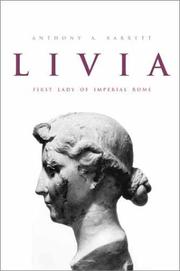
ISBN: 128174073X 9786611740733 0300127162 9780300127164 9780300091960 0300091966 0300102984 9780300102987 6611740732 Year: 2002 Publisher: New Haven Yale University Press
Abstract | Keywords | Export | Availability | Bookmark
 Loading...
Loading...Choose an application
- Reference Manager
- EndNote
- RefWorks (Direct export to RefWorks)
Livia (58 B.C.-A.D. 29)-the wife of the first Roman emperor, Caesar Augustus, and mother of the second, Tiberius-wielded power at the center of Roman politics for most of her long life. Livia has been portrayed as a cunning and sinister schemer, but in this biography (the first in English devoted to her) Livia emerges as a much more complex individual. Achieving influence unprecedented for a woman, she won support and even affection from her contemporaries and was widely revered after her death. Anthony A. Barrett, author of acclaimed biographies of Caligula and Agrippina, here examines Livia's life and her role in Roman politics. He recounts the events of her life, from her early days as a member of the wealthy and powerful Claudian family through her final conflicts with the new Emperor Tiberius. Barrett also considers how Livia helped shape the pattern of Roman government that prevailed for the next four centuries.
Empresses --- Livia, --- Augusta, --- Julia Augusta, --- Livia Drusilla, --- Rome --- History --- Biography --- Augustus, 30 B.C.-14 A.D. --- Livia
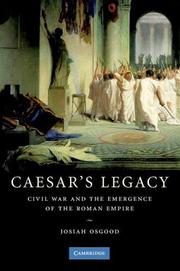
ISBN: 0521671779 0521855829 9780521855822 9780521671774 Year: 2006 Publisher: Cambridge : Cambridge University Press,
Abstract | Keywords | Export | Availability | Bookmark
 Loading...
Loading...Choose an application
- Reference Manager
- EndNote
- RefWorks (Direct export to RefWorks)
Augustus, --- Rome --- History --- Histoire --- Augustus --- Augustus, 30 B.C.-14 A.D. --- Augustus, - Emperor of Rome, - 63 B.C.-14 A.D.
Book
ISBN: 9782251328928 2251328920 Year: 2014 Volume: 78 Publisher: Paris: Les Belles Lettres,
Abstract | Keywords | Export | Availability | Bookmark
 Loading...
Loading...Choose an application
- Reference Manager
- EndNote
- RefWorks (Direct export to RefWorks)
Mécène, descendant des rois étrusques, ami du premier empereur, Auguste, et personnalité phare de la fin de la République romaine et de l'Empire naissant, demeure aujourd’hui encore une figure méconnue. Tout à la fois diplomate, conseiller d’Octavien/Auguste et même, durant un temps, responsable du gouvernement de Rome et de l’Italie, il a joué un rôle majeur dans l’émergence d’un régime d’essence monarchique. Cet engagement politique lui a valu, de la part de ses adversaires sénateurs (et, plus tard, de Sénèque), un portrait noir. Son adhésion à l’épicurisme, notamment, fut instrumentalisée afin de décrédibiliser un chevalier qui jamais n’aurait dû revêtir les responsabilités qui furent les siennes au sein de l’État romain. C’est toutefois essentiellement en tant que protecteur des poètes, Virgile, Horace et Properce en particulier, que Mécène a laissé son nom à la postérité. Très vite, il a symbolisé l’âge d’or du patronage littéraire. Sous son égide, certaines des oeuvres majeures de la littérature latine ont vu le jour, l’Énéide en premier lieu. Il a été l’un des fers de lance d’une politique culturelle visant à donner à Rome une littérature capable de rivaliser avec celle du monde grec. Personnalité singulière ayant tout à la fois le goût de l’ombre et celui de la provocation, figure centrale d’un cercle épicurien qui servit sans doute en partie de thérapie à sa nature inquiète, Mécène est une figure hors norme de l’histoire de Rome. Résultat de cinq années de recherche, cette biographie renouvelle le portrait de Mécène, éclairant tout à la fois son action politique, son oeuvre de protecteur des lettres latines et les singularités d’un personnage peu orthodoxe, controversé et souvent incompris.
Maecenas, Gaius Cilnius, --- Rome --- History --- Histoire --- Mécène --- Critique et interprétation. --- Rome - History - Augustus, 30 B.C.-14 A.D.
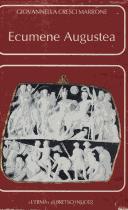
ISBN: 8870628299 9788870628296 Year: 1993 Volume: 14 Publisher: Roma Bretschneider
Abstract | Keywords | Export | Availability | Bookmark
 Loading...
Loading...Choose an application
- Reference Manager
- EndNote
- RefWorks (Direct export to RefWorks)
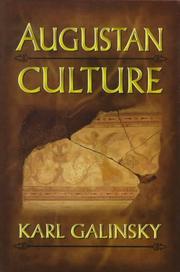
ISBN: 069104435X 9780691044354 0691058903 9780691058900 Year: 1998 Publisher: Princeton, N.J. Princeton University Press
Abstract | Keywords | Export | Availability | Bookmark
 Loading...
Loading...Choose an application
- Reference Manager
- EndNote
- RefWorks (Direct export to RefWorks)
Grand political accomplishment and artistic productivity were the hallmarks of Augustus Caesar's reign (31 B.C. to A.D. 14), which has served as a powerful model of achievement for societies throughout Western history. Although much research has been done on individual facets of Augustan culture, Karl Galinsky's book is the first in decades to present a unified overview, one that brings together political and social history, art, literature, architecture, and religion. Weaving analysis and narrative throughout a richly illustrated text, Galinsky provides not only an enjoyable account of the major ideas of the age, but also an interpretation of the creative tensions and contradictions that made for its vitality and influence. Galinsky draws on source material ranging from coins and inscriptions to the major works of poetry and art, and challenges the schematic concepts and dichotomies that have commonly been applied to Augustan culture. He demonstrates that this culture was neither monolithic nor the mere result of one man's will. Instead it was a nuanced process of evolution and experimentation. Augustan culture had many contributors, as Galinsky demonstrates, and their dynamic interactions resulted in a high point of creativity and complexity that explains the transcendence of the Augustan age. Far from being static, its sophisticated literary and artistic monuments call for the active response and involvement of the reader and viewer even today.
Rome --- Civilisation --- History --- Civilization. --- -Rome --- Augustus, 30 B.C.-14 A.D. --- Civilization --- Rome - History - Augustus, 30 B.C.-14 A.D. --- Cultuurgeschiedenis. --- Romeinse keizertijd. --- Kultur. --- Kulturpolitik. --- Latein. --- Literatur. --- Religion. --- Kunst. --- Augustus, --- 30 B.C.-14 A.D. --- Roma --- Rome (Empire). --- Römisches Reich. --- Storia --- Intellectual life. --- Histoire --- Civilisation. --- Augustus [Roman emperor] --- Rome - Civilisation
Book
ISBN: 9789026320644 9789022322413 Year: 2007 Publisher: Amsterdam Ambo/Manteau
Abstract | Keywords | Export | Availability | Bookmark
 Loading...
Loading...Choose an application
- Reference Manager
- EndNote
- RefWorks (Direct export to RefWorks)
Augustus [Roman emperor] --- Augustus --- Emperors --- Rome --- Biography --- Historiography --- History --- Augustus, 30 B.C.-14 A.D. --- Romeinse Rijk --- Augustus (Romeins keizer) --- Geschiedenis --- 1e eeuw v. Chr. --- 1e eeuw --- Geneeskunde --- Techniek (wetenschap) --- Atlas --- Museum
| Listing 1 - 10 of 53 | << page >> |
Sort by
|

 Search
Search Feedback
Feedback About UniCat
About UniCat  Help
Help News
News